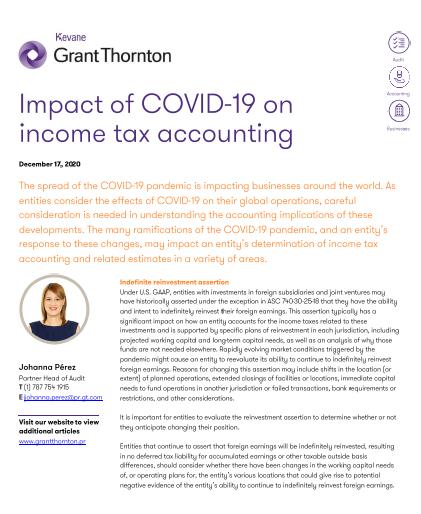-
Financial statements audits
Financial statement audits
-
Compliance audits
Compliance audits
-
Compilations and reviews
Compilations and audit
-
Agreed-upon procedures
Agreed-upon procedures
-
Tax compliance
Business Tax
-
Global mobility services
Through our global organisation of member firms, we support both companies and individuals, providing insightful solutions to minimise the tax burden for both parties.
-
Sales and use tax and indirect taxes
SUT/ VAT & indirect taxes
-
Tax incentives
Navigating the complex landscape of tax incentives in Puerto Rico can be challenging. Whether you're looking to benefit from the Export Services Act (Act 20), the Individual Investors Act (Act 22), or other incentives under Act 60, we provide tailored advice to help you maximize your tax benefits and ensure compliance. Let us help you unlock the potential of doing business in Puerto Rico.
-
Transfer Pricing
The laws surrounding transfer pricing are becoming ever more complex, as tax affairs of multinational companies are facing scrutiny from media, regulators and the public

-
Business consulting
Our business consulting services can help you improve your operational performance and productivity, adding value throughout your growth life cycle.
-
Business Risk Advisory
Risk is inevitable but manageable. We deliver relevant, timely and practical advices to aid organizations manage risk and improve business performance. We can help you identify, understand and manage potential risks to safeguard your business and comply with regulatory requirements.
-
Technology Advisory
We provide comprehensive solutions to safeguard your business and ensure operational resilience and compliance. Our expert team offers a range of technology advisory services designed to address your cybersecurity needs, enhance business continuity, and manage security effectively.
-
Transactional advisory services
Transactions are significant events in the life of a business – a successful deal that can have a lasting impact on the future shape of the organizations involved. Because the stakes are high for both buyers and sellers, experience, determination and pragmatism are required to bring deals safely through to conclusion.
-
Forensic and investigative services
At Grant Thornton, we have a wealth of knowledge in forensic services and can support you with issues such as dispute resolution, fraud and insurance claims.

The spread of the COVID-19 pandemic is impacting businesses around the world. As entities consider the effects of COVID-19 on their global operations, careful consideration is needed in understanding the accounting implications of these developments. The many ramifications of the COVID-19 pandemic, and an entity’s response to these changes, may impact an entity’s determination of income tax accounting and related estimates in a variety of areas.
Indefinite reinvestment assertion
Under U.S. GAAP, entities with investments in foreign subsidiaries and joint ventures may have historically asserted under the exception in ASC 740-30-25-18 that they have the ability and intent to indefinitely reinvest their foreign earnings. This assertion typically has a significant impact on how an entity accounts for the income taxes related to these investments and is supported by specific plans of reinvestment in each jurisdiction, including projected working capital and long-term capital needs, as well as an analysis of why those funds are not needed elsewhere. Rapidly evolving market conditions triggered by the pandemic might cause an entity to reevaluate its ability to continue to indefinitely reinvest foreign earnings. Reasons for changing this assertion may include shifts in the location (or extent) of planned operations, extended closings of facilities or locations, immediate capital needs to fund operations in another jurisdiction or failed transactions, bank requirements or restrictions, and other considerations.
It is important for entities to evaluate the reinvestment assertion to determine whether or not they anticipate changing their position.
Entities that continue to assert that foreign earnings will be indefinitely reinvested, resulting in no deferred tax liability for accumulated earnings or other taxable outside basis differences, should consider whether there have been changes in the working capital needs of, or operating plans for, the entity’s various locations that could give rise to potential negative evidence of the entity’s ability to continue to indefinitely reinvest foreign earnings.
Entities that no longer intend to assert indefinite reinvestment should consider whether the deferred tax liability recognized during the period is appropriate and represents the tax effects of repatriation at each tier of the organization.
Entities that assert a one-time repatriation from accumulated earnings and profits is needed but that the remainder will continue to be reinvested indefinitely should consider whether there is sufficient information supporting a partial reinvestment assertion.
Valuation allowance
Economic conditions resulting from the COVID-19 pandemic may cause an entity to reevaluate its determination of whether its deferred tax asset can be realized, particularly if the entity expects a component of the deferred tax asset to expire in the near term or if the entity has historically relied on projections of future income.
A valuation allowance is used to reduce the deferred tax asset to the amount that is more likely than not to be realized. Evidence of future taxable income under ASC 740-10-30-18 includes:
- taxable income in prior carryback years if carryback is permitted under the relevant tax law
- future reversals of existing taxable temporary differences
- tax planning strategies
- future taxable income exclusive of reversing temporary differences and carryforwards
Under ASC 740-10-45-20, entities are required to recognize a change in the valuation allowance in an interim period through the estimated annual effective tax rate when the change relates to either (1) the origination of deferred tax assets during the current year, or (2) deferred tax assets existing as of the beginning of the year that are expected to be realized as a result of current-year ordinary income. If, on the other hand, an entity recognizes a change in the valuation allowance for deferred tax assets existing at the beginning of the year that are expected to be realized in future years, the change should be recognized in full in the interim period of the change.
The continuing effects of COVID-19 may result in the impairment of goodwill, tangible or intangible assets, or the right-of-use assets related to leases, among other things. To the extent that an impairment reduces a component of the deferred tax liability or increases a component of the deferred tax asset, the valuation allowance may be impacted as sources of future taxable income change.
Changes in tax law or tax rate
An entity recognizes the effects of an enacted change in tax laws or rates in the period that includes the enactment date—that is, the date a tax bill becomes law—in accordance with ASC 740-270-25-5. Federal tax law and rate changes, for example, are enacted when the legislation is signed by the president. The effects of a change in tax laws or tax rates cannot be anticipated in the financial statements, so the effect of these changes should not be recognized until the period in which the change is enacted.
Many governments are considering various economic incentive proposals in response to the COVID-19 pandemic. This aid may be in the form of tax cuts, credits, grants, or other legislative benefits. When this type of legislation is enacted, an entity should adjust its estimated annual effective tax rate in the interim period that includes the enactment date.
Proposals currently being considered for U.S. federal income taxes include the reduction or elimination of the 80% limitation on post-tax reform net operating losses and the reduction or elimination of the cap on interest deductions. If passed, entities may need to consider the effects of these and other potential income tax regulations on their interim income taxes and to reevaluate their need for, and the amount of, a valuation allowance.
It is important for entities to carefully evaluate the nature of any government assistance received. Certain incentives may come in the form of refundable or transferrable credits or government grants. Accounting for these types of credits and incentives may be outside the scope of ASC 740. In these circumstances, entities generally account for these types of government assistance under ASC 450, Contingencies.
Tax accounting method changes
As entities evaluate their capital needs, they may also consider changing to a more advantageous method of accounting and reporting for income tax purposes. For example, an entity may change its method of capitalizing costs to inventory under Section 263A of the Internal Revenue Code or the timing of deducting prepaid expenses to a more favorable method.
Changes from one proper tax method of accounting to another may be either automatic or non-automatic under tax authority regulations. The guidance in ASC 740-10-55-59 through 55-61 addresses the temporary differences created when a taxpayer changes its method of accounting for an item on its tax return. Generally, the income tax accounting consequences of automatic method changes are reflected in the financial statements in the period when management determines that the entity qualifies for a method change and management has the intent and ability to request the change. Non-automatic method changes require tax authority consent. As a result, entities should not reflect the income tax accounting impact of non-automatic method changes in the financial statements until approval is granted.
Estimated annual effective tax rate in interim periods
As entities evaluate changes in operations in this unprecedented time, they may conclude under ASC 740-270-25-3 that they cannot reliably estimate one or more components of their overall estimated annual effective tax rate, which may lead them to prepare a separate computation for one or more individual tax jurisdictions.
In general, an entity recognizes income tax expense in interim periods based on the overarching view that each period is an integral part of the annual period. Under that rationale, the entity estimates its overall annual effective tax rate and applies that rate to its year-to-date ordinary income or loss. If an entity is unable to reliably estimate its annual effective tax rate, the actual year-to-date tax rate may be the best estimate of the annual effective tax rate. Additionally, if an entity is unable to reliably estimate individual items within consolidated ordinary income, it should recognize the tax effect of those items in the period the item is reported. This may apply to a particular jurisdiction or to a particular component of ordinary income. Entities using a discrete approach to one or more components of the overall income tax expense or benefit will generally need to disclose their inability to reliably project such income.
As a result of COVID-19, an entity may identify significant unusual or infrequently occurring items, such as goodwill or asset impairments, significant loan or lease modifications, debt restructuring, and other significant events. In determining the estimated annual effective tax rate, an entity excludes significant unusual or infrequently occurring items only when those items are separately presented either on the face of the financial statements or in the disclosures related to other comprehensive income. The tax effects of these unusual or infrequently occurring items are recognized in the interim period when the transaction arises.
It is important to understand whether an impairment or related event is, in fact, unusual or infrequently occurring or whether such events should be considered in updating the estimated annual effective tax rate that is applied to year-to-date ordinary income. A corresponding change in the valuation allowance assessment as a result of an unusual or infrequently occurring transaction may impact either the estimated annual effective tax rate or tax expense in the period the event occurs.
Source:
Grant Thornton, On the Horizon March 27, 2020
